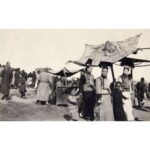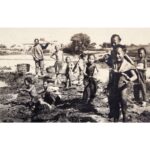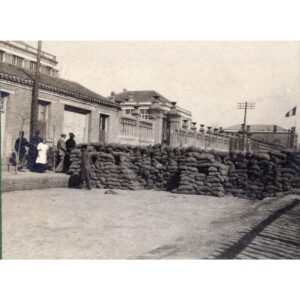Photography Manchu Women at the Market
A black-and-white photograph showing three Manchu women walking through the market, leading two children by the hands. Manchu women are recognised by the typical erbatou 二把頭 hairstyle, which consists of two figs attached to each side of the head. The hairstyles are reinforced with an additional wire frame and extensions, and adorned with various decorations – from flowers to jewellery. The clothing of the first two Manchu women and the third one behind them differs. The latter has a 護領 wrapped scarf instead of the characteristic huling collar. All three wear a majia 馬甲 vest over a long lined robe. This combination was often the informal dress of Manchu women. The vest is in the shape of a pipajin majia 琵琶襟馬甲; it is one of the four typical shapes with front fastening. Characteristically, the side of the front fold is cut asymmetrically, with a slight incision at the neck and a deeper square cut at the waist. Vests were worn on various occasions. The everyday ... more
A black-and-white photograph showing three Manchu women walking through the market, leading two children by the hands. Manchu women are recognised by the typical erbatou 二把頭 hairstyle, which consists of two figs attached to each side of the head. The hairstyles are reinforced with an additional wire frame and extensions, and adorned with various decorations – from flowers to jewellery. The clothing of the first two Manchu women and the third one behind them differs. The latter has a 護領 wrapped scarf instead of the characteristic huling collar. All three wear a majia 馬甲 vest over a long lined robe. This combination was often the informal dress of Manchu women. The vest is in the shape of a pipajin majia 琵琶襟馬甲; it is one of the four typical shapes with front fastening. Characteristically, the side of the front fold is cut asymmetrically, with a slight incision at the neck and a deeper square cut at the waist. Vests were worn on various occasions. The everyday vest, for example, was simpler, more modestly decorated, and made of less prestigious materials. The clothes are lined to provide more comfort on cold winter days.
The photograph is the 155th of 449 photographs of Beijing and its surroundings in the album of Ivan Skušek Jr., purchased during his stay in Beijing (1914–1920). In the handwritten inventory of the album, the photograph is referred to as Chinesen-Frau des Mittelstandes. (DZ, MV)



































Do you have a comment or additional information about the subject?